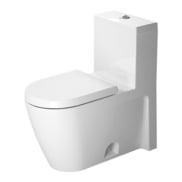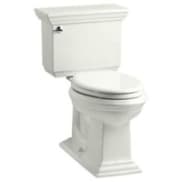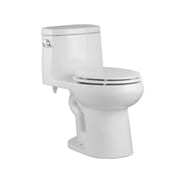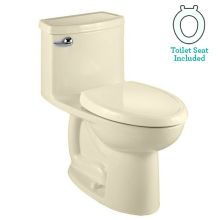How to Increase Toilet Flush Pressure
Toilet flush pressure keeps the toilet clean and ready to use - It’s important to keep it moving.

The average toilet operates using gravity, relying on the water pressure from the tank to flush and clean the bowl, but sometimes that pressure begins to fade. Through the regular use of the toilet, even a well-maintained system will inevitably show signs of wear and age. Of course, this doesn’t mean that when a water pressure problem surfaces, you can’t do anything about it. In fact, there are a few simple tips and tricks that you can use to increase the flushing power of your toilet. You don’t have to be a master plumber to get the toilet flushing like new. Anyone can diagnose what may be wrong with the toilet itself and even make their toilet perform better.
Check for Clogs
If there’s something amiss with a toilet, you have to start with the most basic toilet dilema: the clog. It should take no more than two minutes for your toilet to flush, empty out entirely, and then refill the tank again. Anything slower than that and you’ve got a problem. The toilet drain uses gravity to siphon the waste water out, and when that siphon is clogged, it can change how quickly the water exits and refills in the bowl.
In order to see if your toilet has a partial plug slowing down the works, pour a gallon of water into the toilet bowl to see if it flushes. If it reacts slowly or doesn’t flush right away, you may have a clog. The best thing to do is to clear the clog to restore your flushing power.
Water Level
Slightly more complicated, but no less essential to water pressure, is checking the amount of water your tank holds and can deliver with every flush. If there’s not enough water in the tank, it won’t be able to do the job.
First, remove your toilet tank lid to look inside. With newer toilets, there is a mark on the side of the tank to indicate where the water level should be for optimal flushing power. It should always be well below the edge of the overflow tube in the tank to keep the tank water from siphoning into the overflow tube, which will continually run the toilet and waste water.
If you see that the water level is too low, then you may have an answer to your problem. Adjusting your water tank float assembly could be a simple fix. The water float assembly will either be a cup float or a ball float, two different operations that perform the same function. The levers float at the top of the water and turn the fill valve on or off, depending on how much water is already in the tank.
In order to adjust a cup float, the tank needs to be empty. To empty your toilet tank:
- Turn off the water to the toilet at the shut-off valve.
- Remove the tank lid.
- Flush the toilet. Make sure the tank drains completely.
Once the tank is empty, you can adjust the float with just a few simple steps. To adjust a cup float:
- Pinch the clip that holds the cup to the fill valve shaft and slide the float up to raise the water level.
- Make sure that the critical level mark on the float stays one inch above the top edge of the overflow valve.
- Turn the water back on at the shutoff valve.
- Watch the water level to be sure it is set at the right height.
- Flush the toilet to determine if the water pressure has improved.
If the toilet has a ball float, the process is much less complicated. With the water still on and the tank full, the ball float height is adjusted by turning a screw at the top of the fill valve. This adjusts the tension in the arm and raises the float to in turn raise the water level. Flush the toilet and monitor the water pressure. With more water in the tank, the force it exerts on the bowl should improve.
Clean Buildup
The next place to start investigating a loss in flushing power is the toilet’s water tank. It may be necessary to clear up all of the built up junk that can fill your tank over time. Hard water, calcium, and other mineral deposits, and the grime collected by standing water can build up along the walls of your tank. This easily transfers grime to other parts of the toilet and can prevent the moving parts inside the toilet from working as they should. Every so often, you may need to go in and clear the tank, just to keep the rest of the system clean and flowing smoothly.
In order to clean the tank, start by turning off the water supply and emptying the tank. Using a gallon of bleach, soak the buildup in the tank to let it dissolve the minerals. Allow it to sit in the tank for no more than 15 to 20 minutes before flushing the toilet to drain the bleach away. If necessary, scrub at any remaining grime to carefully remove it from the tank wall.
Turn the water to the tank back on and let it fill. Once filled, flush the toilet and rinse away the bleach and grime from inside the tank. Flush and refill the tank as many times as necessary to remove the bleach from the tank.
Repeat the bleach treatment as necessary, but keep in mind that bleach can deteriorate the seals in the toilet, so don’t leave it on the surface for very long. It is important to note that bleach should only be used in well ventilated areas, and it should never be mixed with other chemicals or cleaning solutions. Make sure to get the bleach completely rinsed out of the tank each time.
Once the buildup is removed, you should see some noticeable improvement in the amount of water pressure flowing through your toilet when you flush.
Clear Flush Holes
Another trick is to clear the flush holes, or siphon jets, in the toilet bowl. These are usually located underneath the inside of the rim of the toilet bowl. These small holes push water from the tank down the sides of the toilet bowl to make sure all waste water flushes down the drain. Over time, the siphon jets will inevitably become blocked with mineral deposits. Clearing up the mineral deposits can provide more water pressure.
To do this, you’ll need to empty the tank and the toilet bowl. Turn off the water supply to the toilet before flushing the toilet, then watch to be sure the tank empties out. Once the tank is empty, either let the toilet bowl dry, or take a rag to the inner rim of the bowl around the flush holes. Next, take a sturdy, waterproof, duct tape and apply it over the holes. The idea is to block the holes entirely, so they don’t leak.
Once they are taped off, pour a gallon or more of white vinegar into the toilet tank. Flush the toilet and check that the tape held securely over the siphon jets. The tape should trap the white vinegar in the jets, allowing it to dissolve the mineral buildup in the holes. Let the vinegar sit for at least a half an hour, but it can stay in the toilet overnight if necessary, as long as the water supply can be left off and the toilet unused.
After the vinegar has had a chance to work, remove the tape and turn the water supply back on. Flush the toilet a few times to clear out the vinegar. The siphon jets should be cleared and the water pressure improved. You can also take a bristled bottle brush to the flush holes to gently scrub away any stubborn mineral deposits that remain. This is a quick maintenance cleaning trick that can be done once a year or so, just to keep the buildup at a minimum and your toilet in tiptop shape.
Toilet Age
How old is your toilet? If it’s reached that 25 year mark, it may be time to look into something newer. With old toilets, the wear and tear adds up, and multiple parts can go bad over time. In the long run, if your toilet is older, it may be better to start fresh. Take the time to shop around, compare prices and features to find the best fit for your home. With a little research, you may find it more cost effective to replace your toilet than to pay for the repairs if these solutions don’t bring results.
Flushing power is important for your toilet’s smooth and reliable operation. Just because plumbing problems are bound to happen now and then doesn’t mean that you can’t take care of them yourself. If you find that your toilet is losing water pressure, these DIY tips can help you restore, and even increase, a toilet’s flush power.





